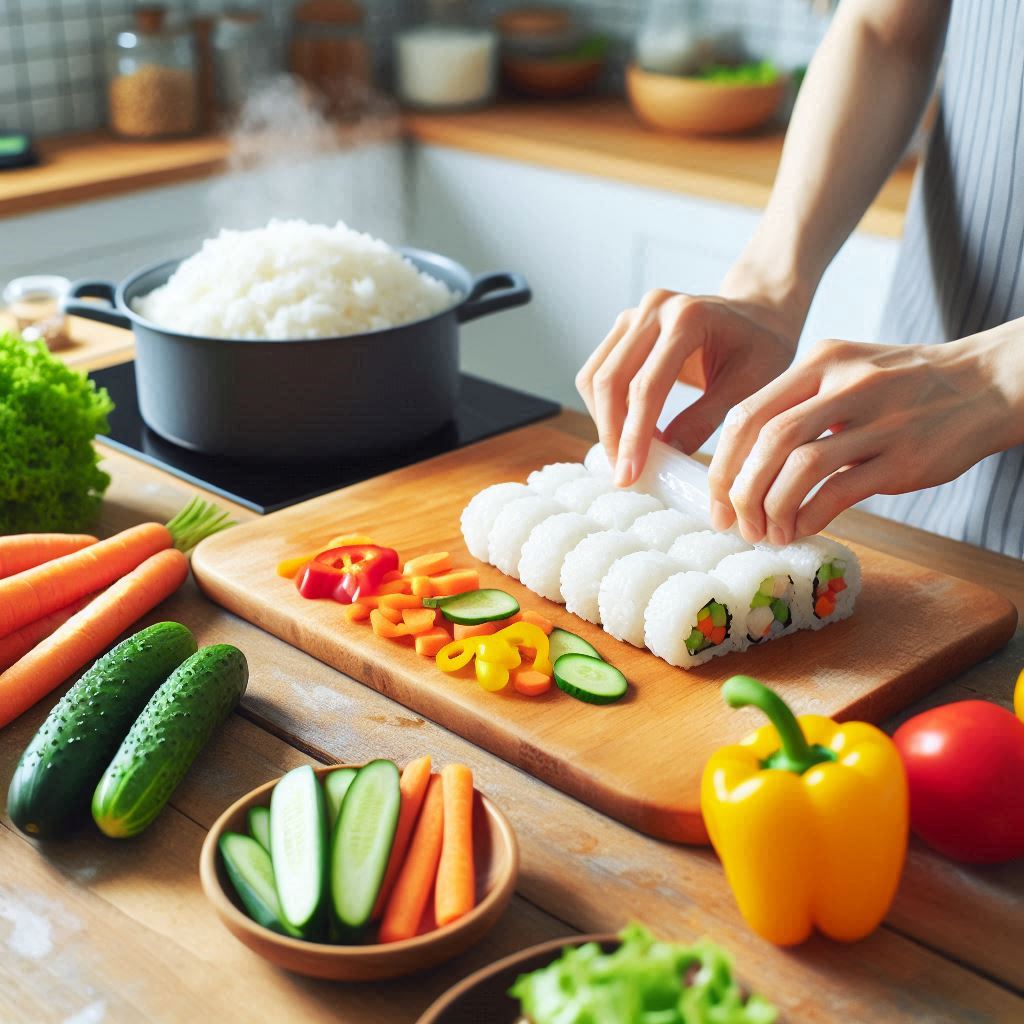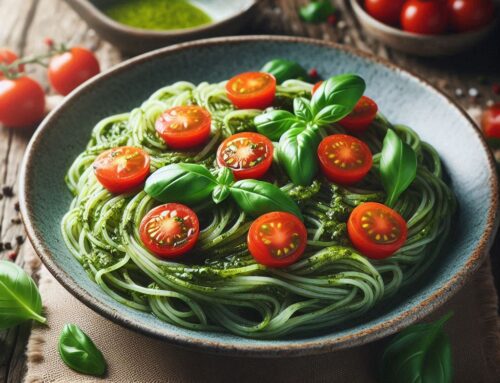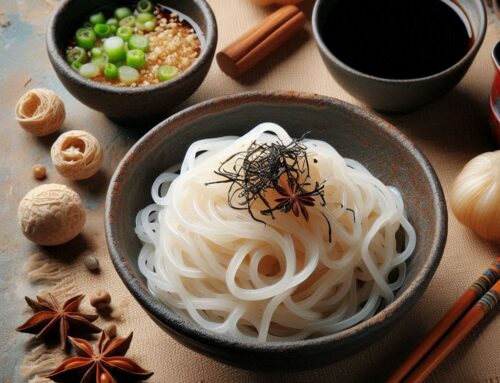
Introduction: What is Kimbap and Why Choose Konjac Rice?
Kimbap, a beloved Korean dish, is often described as the Korean version of sushi. It consists of steamed white rice and various fillings such as vegetables, eggs, and meats, all neatly rolled in sheets of seaweed. This versatile meal can be enjoyed as a snack or a full meal and is appreciated for its portability and delightful combination of flavors.
However, for those seeking a healthier alternative to traditional kimbap, incorporating konjac rice can be an excellent choice. Konjac rice is made from the konjac plant’s root, known for its high fiber content and low-calorie profile. One of the standout benefits of konjac rice is its ability to help you feel full longer due to its glucomannan fiber content, which aids in digestion and promotes satiety.
In terms of nutrition facts, konjac rice offers a remarkable advantage: it contains almost no calories or carbohydrates while being gluten-free and rich in dietary fiber. This makes it an ideal ingredient for crafting low-calorie kimbap that doesn’t compromise on taste or nutritional value. By choosing konjac rice for your kimbap creations, you can enjoy this traditional dish with added health benefits without sacrificing flavor or satisfaction.
The Health Benefits of Using Konjac Rice in Kimbap
Kimbap, a beloved Korean dish, is taking on a healthier twist with the incorporation of konjac rice—a fiber-rich and low-calorie alternative to traditional white rice. This innovative ingredient is gaining popularity among health-conscious individuals seeking to enhance their diet without sacrificing flavor.
One of the most significant health benefits of using konjac rice in kimbap is its role in weight management. As a low-calorie food, it allows you to enjoy your favorite dishes while keeping calorie intake in check, making it an ideal choice for those following a low-calorie diet. Additionally, konjac rice is packed with dietary fiber, which promotes satiety and helps control hunger pangs, further supporting weight management efforts.
For individuals managing diabetes or looking for diabetic-friendly substitutes, konjac rice offers an excellent solution. Its low glycemic index means it has minimal impact on blood sugar levels compared to regular rice. This characteristic makes it a smart choice for maintaining stable blood glucose levels after meals.
Moreover, the konjac plant from which this rice alternative is derived has been linked to various health benefits beyond just being a substitute ingredient. It may aid digestion and support gut health due to its high fiber content while potentially assisting in lowering cholesterol levels.
Incorporating konjac rice into kimbap not only enhances its nutritional profile but also aligns with modern dietary preferences focused on health and wellness. Whether you’re seeking better weight management or looking for diabetic-friendly options, this versatile ingredient offers numerous advantages that cater to diverse dietary needs.
Essential Ingredients for Making Konjac Rice Kimbap at Home
Creating konjac rice kimbap at home is a delightful way to enjoy a healthy and flavorful Korean dish. To start, you’ll need an essential ingredients list that includes the star of the show: konjac rice. This low-calorie alternative to traditional rice is perfect for those looking to enjoy kimbap without compromising on health goals.
First, gather your konjac rice ingredients list: konjac rice itself, water for rinsing, and a pinch of salt for seasoning. The next crucial component is the Korean seaweed sheets, known as gim, which will wrap all your delicious fillings together.
When it comes to kimbap fillings ideas, the possibilities are endless. For a classic approach, consider using julienned carrots, spinach seasoned with sesame oil and garlic, pickled radish (danmuji), and strips of cooked egg or tofu for protein. These healthy kimbap ingredients not only add vibrant colors but also provide essential nutrients.
Feel free to experiment with other fillings such as avocado slices for creaminess or bell peppers for an extra crunch. Whether you stick with traditional options or explore new combinations, making konjac rice kimbap at home allows you to customize each roll according to your taste preferences while keeping it nutritious and satisfying.
Step-by-Step Guide to Preparing and Assembling Your Konjac Rice Kimbap
Creating your own konjac rice kimbap at home can be a delightful and rewarding experience. This step-by-step guide will walk you through the process, ensuring you achieve perfect results every time.
**Step 1: Preparing the Konjac Rice**
Begin by thoroughly rinsing the konjac rice under cold water to remove any excess starch or odor. Once rinsed, cook the rice according to package instructions. A useful konjac cooking tip is to simmer it gently until it reaches a slightly sticky consistency, similar to traditional sushi rice.
**Step 2: Preparing the Fillings**
While your konjac rice is cooking, prepare your desired fillings. Common choices include julienned carrots, spinach, pickled radish, and thinly sliced omelet. Feel free to get creative with your ingredients—just ensure they are cut into thin strips for easy rolling.
**Step 3: Assembling Your Kimbap**
Lay a sheet of seaweed (nori) on a bamboo mat or clean surface with the shiny side down. Spread an even layer of cooled konjac rice over two-thirds of the nori sheet, leaving space at one end for sealing.
**Step 4: Adding Fillings**
Place your prepared fillings in neat rows across the center of the rice-covered nori sheet. Be careful not to overfill as this can make rolling difficult and messy.
**Step 5: Rolling Technique for Kimbap**
Using both hands, lift the edge of the bamboo mat closest to you and begin rolling away from yourself while applying gentle pressure to keep everything compact. Continue rolling until you reach the end of the nori sheet; use a few grains of cooked konjac rice as glue if needed to seal it shut.
**Step 6: Slicing Your Kimbap**
With a sharp knife dipped in water (to prevent sticking), slice your kimbap roll into bite-sized pieces about half an inch thick. Arrange them on a platter and serve immediately for best taste and texture.
By following these homemade kimbap recipe steps with care and attention, you’ll masterfully create delicious rolls that are both healthy and satisfying!
Tips for Perfecting Your Low-Calorie Kimbap Every Time
Creating the perfect low-calorie kimbap can be a delightful culinary journey, especially when using konjac rice as a healthier alternative. To ensure your kimbap rolls are both delicious and visually appealing, consider these best practices.
First, when making kimbap with konjac rice, it’s crucial to properly prepare the rice to avoid excess moisture that could lead to soggy seaweed wraps. Rinse the konjac rice thoroughly under cold water and let it drain completely. This step helps remove any residual odor and ensures that the rice is light and fluffy.
To prevent soggy seaweed wraps, always work with dry hands and tools. Lay out your seaweed sheet on a bamboo mat or clean surface, ensuring it’s completely dry before adding any ingredients. Also, be mindful of how much filling you use; overstuffing can lead to tearing or moisture buildup.
For flavor enhancement in your healthy rolls, experiment with fresh herbs like cilantro or basil for an aromatic touch. You can also incorporate pickled vegetables for a tangy kick without adding extra calories. A sprinkle of sesame seeds or a drizzle of low-sodium soy sauce can elevate your kimbap’s taste profile while keeping it nutritious.
By following these tips, you’ll master the art of making low-calorie kimbap that’s not only healthy but also bursting with flavor every time you roll up a batch!
Kombucha Pairings and Other Healthy Side Dishes to Complement Your Meal
When it comes to enhancing your dining experience with both flavor and health benefits, kombucha pairings and Korean side dishes, known as banchan, offer a delightful combination. Kombucha, a fermented tea rich in probiotics, is not only refreshing but also aids digestion—making it an excellent beverage choice to accompany your meals.
Pairing kombucha with meals can elevate the flavors on your plate. For instance, the tangy effervescence of ginger or citrus-flavored kombucha can complement spicy dishes by balancing heat with acidity. Meanwhile, milder kombuchas like those infused with berries or herbs can enhance the subtle flavors of lighter fare such as salads or grilled vegetables.
Incorporating healthy Korean side dishes into your meal further enriches the experience. Banchan typically includes a variety of small servings that are both nutritious and flavorful. Classic options like kimchi provide probiotics similar to those found in kombucha, supporting gut health while delivering a spicy kick. Other banchan such as seasoned spinach (sigeumchi namul) or marinated bean sprouts (kongnamul muchim) offer nutrient-dense additions packed with vitamins and minerals.
Together, these elements create a harmonious balance of taste and wellness on your table—ensuring that each meal is not only satisfying but also beneficial for your body. Whether you’re hosting a dinner party or enjoying a quiet meal at home, exploring these pairings can transform everyday eating into an extraordinary culinary journey.






